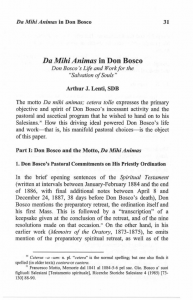by Arthur J. Lenti, SDB
Introduction
The motto Da mihi animas; cetera tolle expresses the primary objective and spirit of Don Bosco’s incessant activity and the pastoral and ascetical program that he wished to hand on to his Salesians. How this driving ideal powered Don Bosco’s life and work-that is, his manifold choices-is the object of this paper.
Subjects:
- Part 1: Don Bosco and the Motto, Da Mihi Animas
- Don Bosco’s Pastoral Commitments on His Priestly Ordination
- The Keepsake
- The 1841 Priestly Resolutions
- The Motto “Da Mihi Animas, Caetera Tolle” Officially Adopted
- The Motto in the Salesian Coat of Arms
- Biblical Source of the Motto, Da Mihi Animas (Give Me the
- Persons)
- Spiritual and Accommodated Sense
- Part 2: Don Bosco’s Understanding of Da Mihi Animas
- The Soul in Don Bosco’s Understanding
- Traditional Dualistic Understanding
- Personalist Understanding of Soul Vis-à-vis the Body
- Three Attitudes Rejected by Personalism- Withdrawal, Eschatologism and Supernaturalism
- Experience of God in History and Involvement with the World
- Liberation of the Oppressed and Exploited Poor and the Establishing of Community
- Part 3: Da Mihi Animas Powering Don Bosco’s Vocational Commitment
- Don Bosco’s Vocational Commitment and Its Inspiration
- Don Bosco ‘s Love and Social Valuation of Young People
- Purpose of the Salesian Vocation in Don Bosco ‘s Words
- “Give Me Souls” and the Education of the Young- the Home Attached to the Oratory
- Don Bosco ‘s Option for the Poor and its Character
- “Give me souls … ” the Poor in the Student Community of the Home
- Part 4: The Active Life as the Special Religious Purpose of the Salesian Congregation
- Priority of the Active Life
- General and Special Purposes of the Salesian Society as a Religious Congregation
- Personal Sanctification through the Work of Charity Undertaken after Christ’s own Example
- Articles 1 and 2 of the Chapter On Purpose in the Earliest Drafts of 1858 and 1860
- Puzzling Re-Writing of Article 1 of the Chapter on Purpose in 1864
- Part 5: Don Bosco’s Social Commitment and His Apolitical Stance (Art. 7 of the Chapter on Purpose of the 1864 Constitutions)
- Don Bosco’s Apolitical Stance
- Don Bosco’s Work of Charity and the Renewal of Society
- Possible Reason for the Prohibition of Political Involvement
- Don Bosco’s Religious-Political Involvement in Church-State Negotiations for the Appointment of Bishops and Exequaturs
- The Problem of Vacant Episcopal Sees
- Don Bosco Involvement in Summary
- Character of the Negotiations and of Don Bosco’s Involvement
- Community and Mission – Religious Consecration for the Exercise of Charity
- Community as Communion for Mission- Article 1 of the
- Chapter on Form of the Society
- Virtues of Religious Consecration and Preeminence of Obedience
- Part 6: Da Mihi Animas and the Education of the Young – the School
- Don Bosco’s Move into Education through the School
- Constitutional Basis and Expansion of the Salesian School Apostolate
- The Salesian School and Don Bosco’s Option for Poor Young People
- Schools Generally for Middle-Class Young People
- Don Bosco’s Abiding Commitment to the Poor Young People
- Role of education and the school in Don Bosco’s Missionary Strategy
- Conclusion

